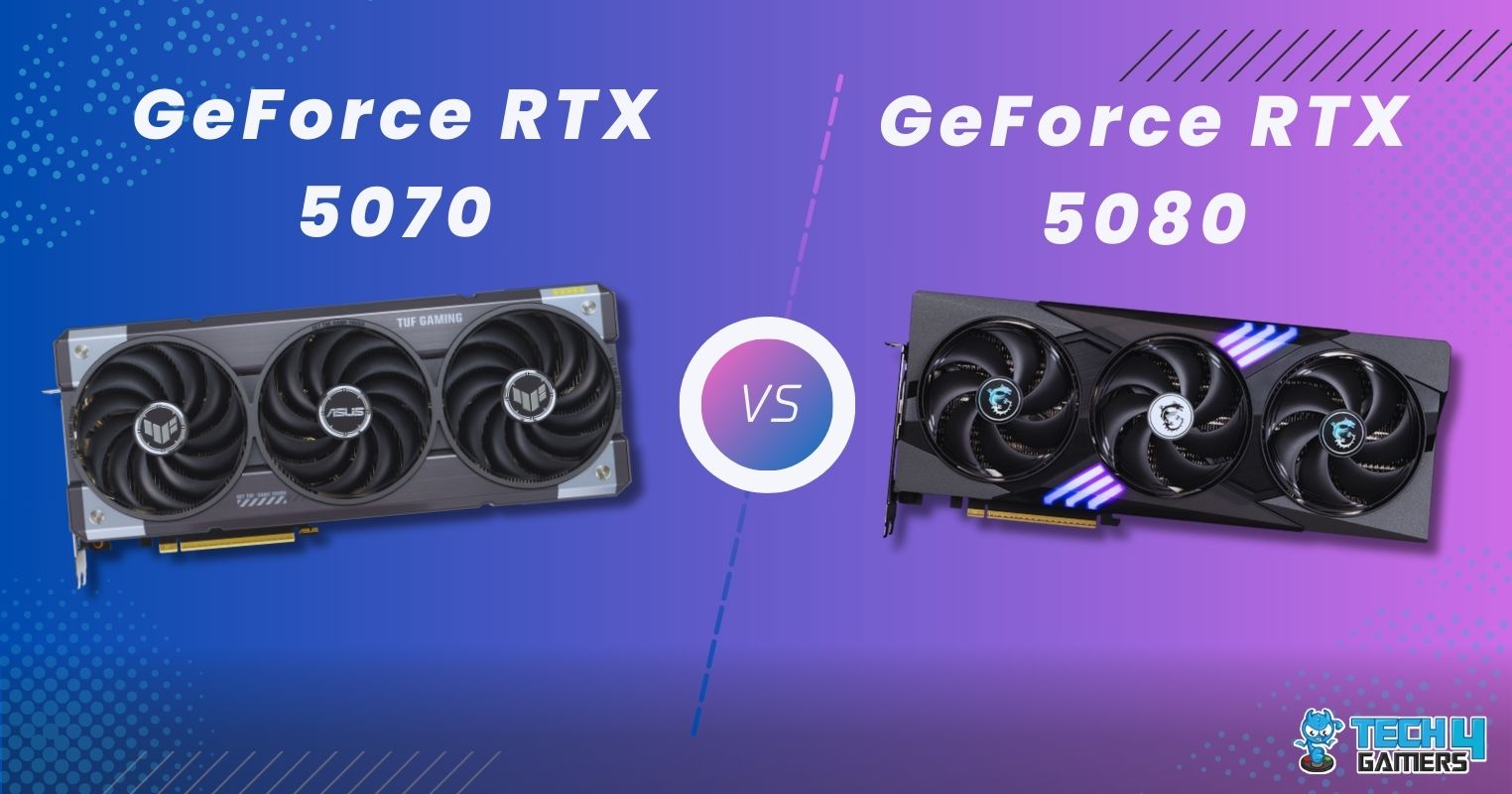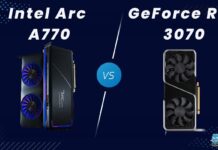Nvidia’s RTX 3050 was launched in January 2022, becoming the cheapest released Nvidia card with ray-tracing capabilities. Another budget-oriented card launched in the same month and year: AMD’s RX 6500 XT. Today, we’ll compare these two entry-level offerings to decide the verdict of RTX 3050 vs RX 6500 XT.
Key Takeaways
- Gaming Performance: The RTX 3050 outperforms the RX 6500 XT by 33.8% in 1080P gaming, leading to smoother gameplay and better visuals.
- Power Efficiency: The RX 6500 XT consumes 21.4% less power than the RTX 3050, making it more energy-efficient.
- Thermal Efficiency: The RX 6500 XT maintains a 4.1% lower average operating temperature than the RTX 3050, resulting in cooler and more stable performance during gaming.
- Pricing and Value: The RX 6500 XT is more budget-friendly, priced 35.8% lower than the RTX 3050.
Comparison Table
| Technical Specs | GeForce RTX 3050 | Radeon RX 6500 XT |
| GPU Name | GA106 | Navi 24 |
| Architecture | Ampere | RDNA 2.0 |
| Transistors | 12,000 million | 5,400 million |
| Shading Units | 2560 | 1024 |
| Tensor Cores | 80 | NA |
| RT Cores | 20 | 16 |
| TMUs | 80 | 64 |
| ROPs | 32 | 32 |
| L1 Cache | 128 KB (per SM) | 128 KB per Array |
| L2 Cache | 2 MB | 1024 KB |
| Memory Bus Width | 128 bit | 64 bit |
| Memory Bandwidth | 224.0 GB/s | 143.9 GB/s |
| Suggested PSU | 300W | 300W |
| Release Date | Jan 4th, 2022 | Jan 19th, 2022 |
| Approximated Price | 230 USD | 160 USD |
| Best Variants | Best RTX 3050 Cards | – |
Architectural Differences
- Process Node: In the realm of process technology, the RTX 3050 leads with its cutting-edge 8nm process node. Meanwhile, the RX 6500 XT employs a 6nm process node.
- Clock Speed: The RTX 3050 boasts a 1552 MHz Base Clock and a 1777 MHz Boost Clock, providing a reliable foundation for gaming. In contrast, the RX 6500 XT raises the bar with a 2310 MHz Base Clock and an impressive 2815 MHz Boost Clock, showcasing its prowess in delivering accelerated performance.
- VRAM: When it comes to memory, the RTX 3050 shines with 8GB of GDDR6 VRAM, ensuring ample space for graphics-intensive tasks. The RX 6500 XT, however, carries 4GB of GDDR6 VRAM, which might raise concerns about its capacity for handling modern AAA games at 1080P, even on modest settings.
- TDP: For power efficiency and heat management, the RTX 3050 operates with a 130W TDP. On the other hand, the RX 6500 XT demonstrates a lower TDP of 107W, hinting at an energy-efficient design for users who prioritize power consumption.
- Supported Technologies: NVIDIA’s RTX 3050 showcases the capability of DLSS (Deep Learning Super Sampling), enhancing gaming visuals and performance through AI-driven upscaling. In contrast, the RX 6500 XT leverages AMD’s FSR (FidelityFX Super Resolution) technology.
RTX 3050 Vs RX 6500 XT: Gaming Benchmarks
Let’s dive into our hands-on experience comparing the gaming benchmarks of the RTX 3050 and RX 6500 XT. We conducted these tests at 1080P across various presets in 8 different games.
Note: Please keep in mind that the FPS figures you see here might exhibit minor variations due to inconsistencies in monitoring software. However, our tests provide a solid basis for performance comparison.
With that being said, here’s a look at the test bench:
Test Bench
- OS: Windows 11
- CPU: Intel Core i7-13700K
- Motherboards: ASRock Z790 Taichi Lite Motherboard
- RAM: Kingston Fury Renegade RGB DDR5 32GB 7200MHz
- SSD: XPG GAMMIX S70 BLADE 2TB NVMe SSD
- PSU: Enermax Revolution D.F. X 1050W
- CPU Cooler: MSI MAG CORELIQUID E360 CPU Liquid Cooler
Red Dead Redemption 2
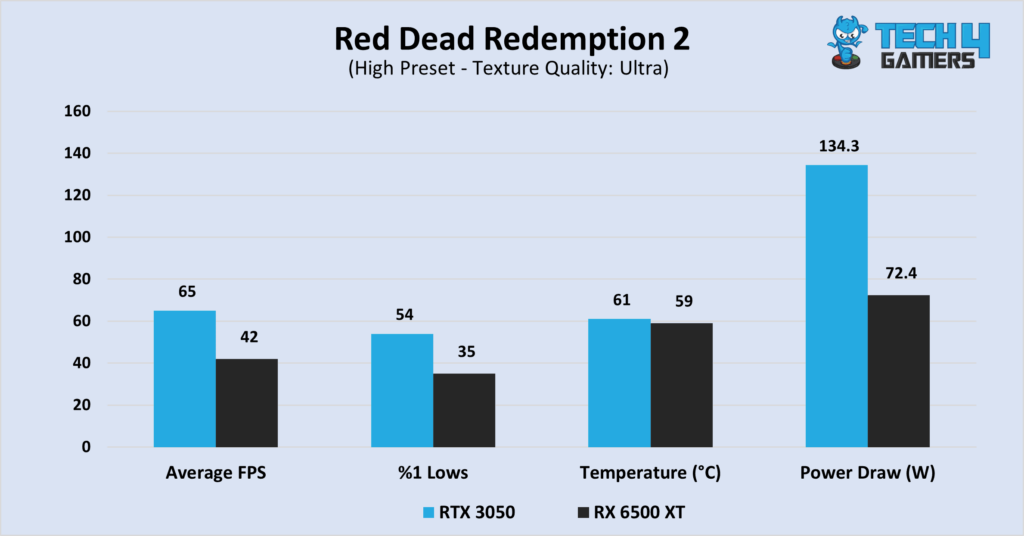
- Starting with our Red Dead Redemption 2 gameplay, the RTX 3050 scores 65 FPS on average, as the RX 6500 XT trails by 54.7%.
- Both GPUs fall under the 60 FPS mark when it comes to the %1 lows. The RTX 3050 scores 54 FPS, while the RX 6500 XT records 35 FPS.
- As for the temperatures, the RTX 3050 (61°C) runs slightly warmer than the RX 6500 XT (59°C) in our testing.
- The power draw figures show a big contrast between the two graphics cards. Nvidia’s RTX 3050 draws 134.3 watts, 85.4% more than the RX 6500 XT’s power draw.
Microsoft Flight Simulator
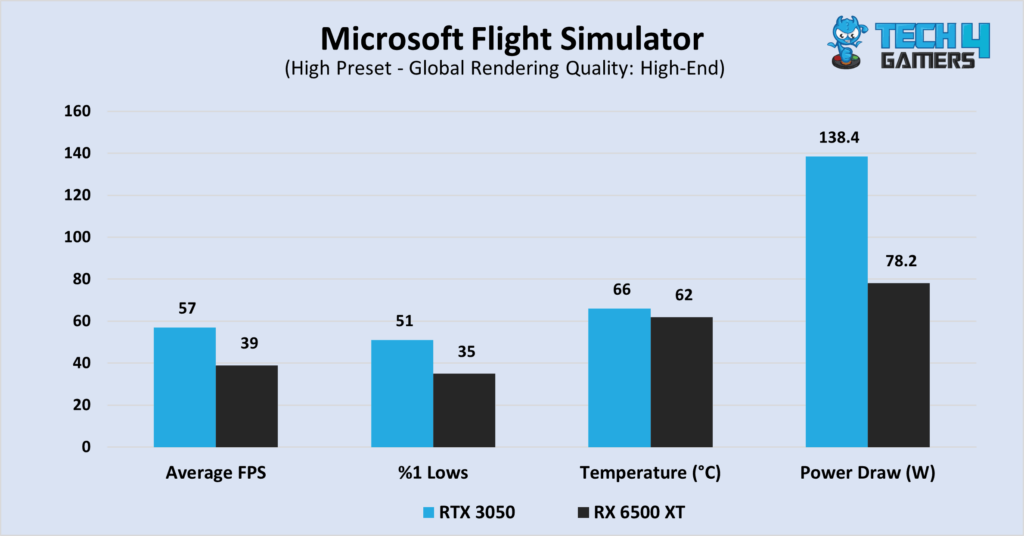
- The RX 6500 XT averages 39 FPS in reply to the 57 FPS of the RTX 3050 during our stress testing.
- In terms of the %1 lows, the RTX 3050 scores 51 FPS, while its AMD competitor scores 35 FPS.
- Moving on to the temperature figures, the RTX 3050 hovers over the 66°C mark while the RX 6500 XT keeps cooler at 62°C.
- This title sees the RTX 3050 consuming 138.4 watts of power. The RX 6500 XT shows us much better power efficiency at 78.2 watts.
Assassin’s Creed: Valhalla
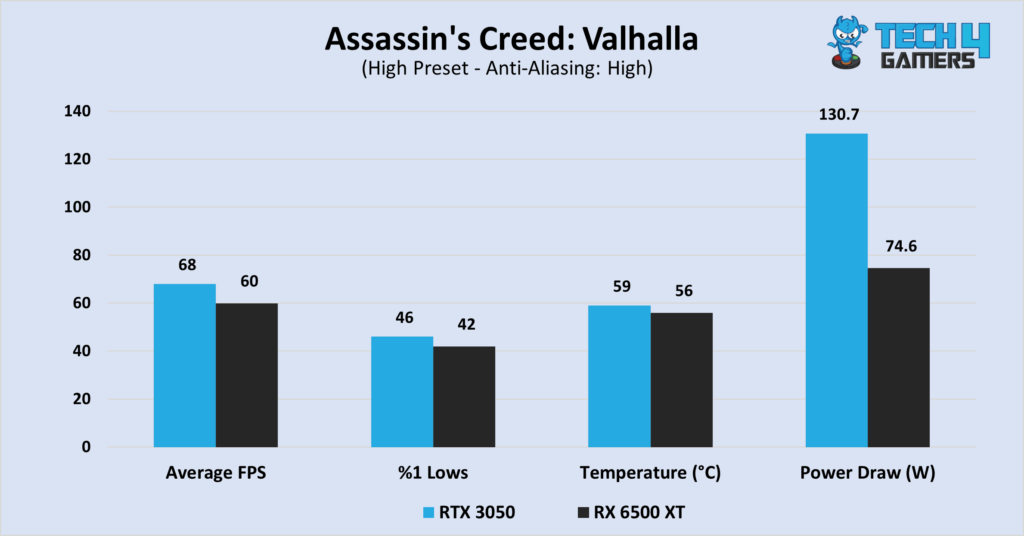
- Looking at our average FPS in Assassin’s Creed: Valhalla, the GeForce RTX 3050 scores 68 FPS, and the 6500 XT is not far behind with 60 FPS.
- The RTX 3050 scores 46 FPS in terms of %1 lows; the RX 6500 XT follows with 42 FPS.
- The thermal statistics show the RTX 3050 running slightly warmer again at 59°C
- As for our power consumption results, the RTX 3050 crosses the 130-watt mark again. In comparison, AMD’s RX 6500 XT uses 74.6 watts on average.
Cyberpunk 2077
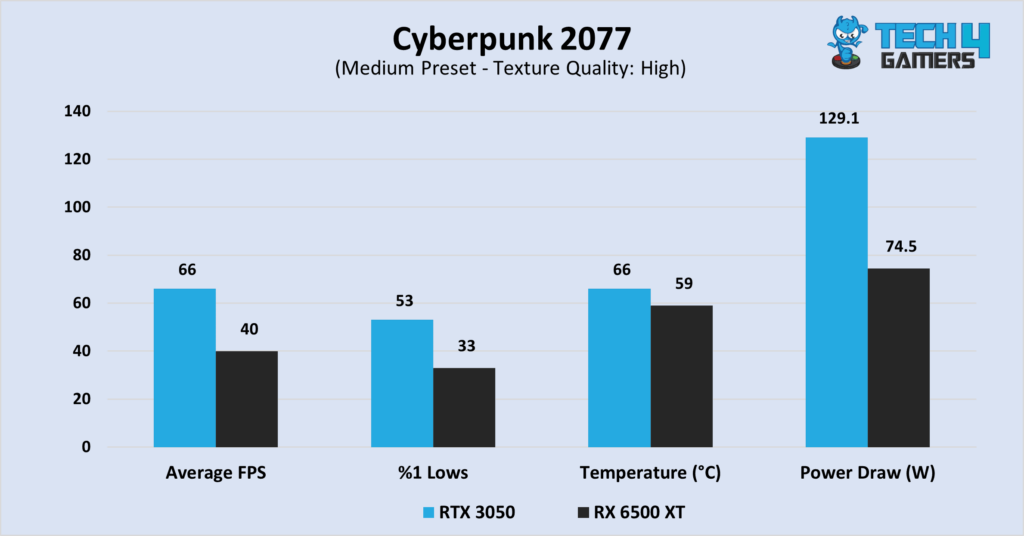
- With our Cyberpunk 2077 gameplay running at the medium preset, the RTX 3050 scores 66 FPS – 65% higher than the Radeon card.
- Moving to our %1 lows, the RTX 3050 has another significant lead, 60.6% higher in this case.
- The RTX 3050 runs at around 66°C in this test, while the RTX 3050 stays under the 60°C mark.
- Looking at the power consumption figures, the RTX 3050 draws 129.1 watts while the 6500 XT draws 74.5 watts.
Horizon Zero Dawn
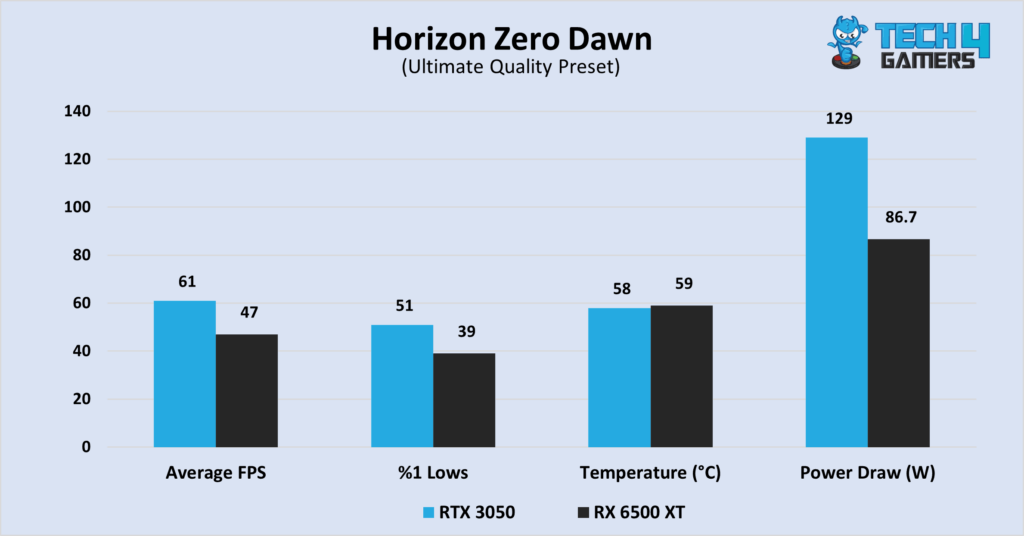
- In this title, we saw the RTX 3050 averages 61 FPS in contrast to the RX 6500 XT’s score of 47 FPS.
- The RTX 3050 recorded 51 FPS, while the Radeon RX 6500 XT managed 39 FPS as far as the %1 low FPS is concerned.
- As for the thermal performance, the RX 6500 XT was seen running 1°C warmer than the RTX 3050 in this test.
- In terms of power draw, the Nvidia GeForce RTX 3050 continues to be a power hog as it recorded 129 watts on average, much higher again compared to its AMD rival.
Hitman 3
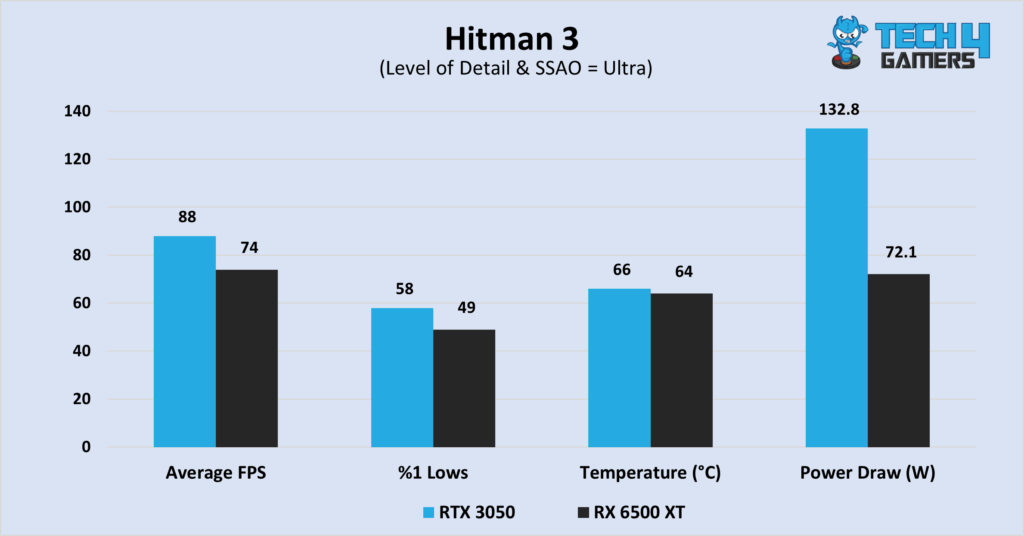
- As we were playing Hitman 3, the RTX 3050 racks up 88 FPS on average, leading AMD’s RX 6500 XT by nearly 19%.
- The RTX 3050 continues to stand out as it scores 58 FPS in terms of the %1 lows here. Conversely, the RX 6500 XT managed 49 FPS.
- In terms of our temperature benchmarking, the Radeon RX 6500 XT runs 2°C cooler in this test.
- Nvidia’s RTX 3050 averaged 132.8 watts of power consumption in this test, 84.1% higher than the RX 6500 XT.
Forza Horizon 5
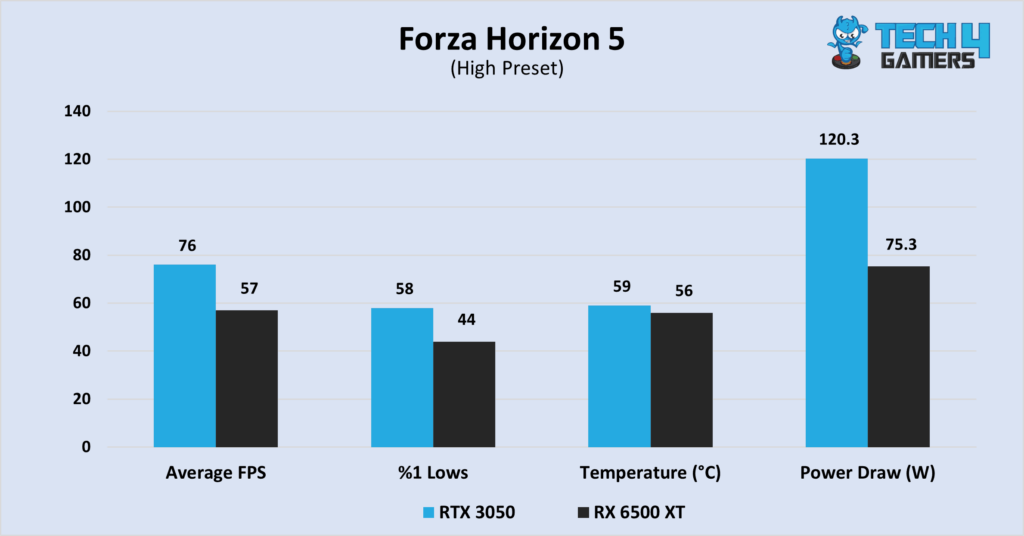
- Moving on to Forza Horizon 5: the RX 6500 XT scores 57 FPS, trailing the Nvidia RTX 3050 by 33.3%.
- Next up, the %1 low figures show the RTX 3050 scoring 31.8% higher than the AMD RX 6500 XT as per our results and benchmarks.
- The Radeon RX 6500 XT shows better thermal efficiency again in our tests.
- This benchmark sees the RTX 3050 using 120.3 watts of power compared to 75.3 watts of the RX 6500 XT.
PUBG: Battlegrounds
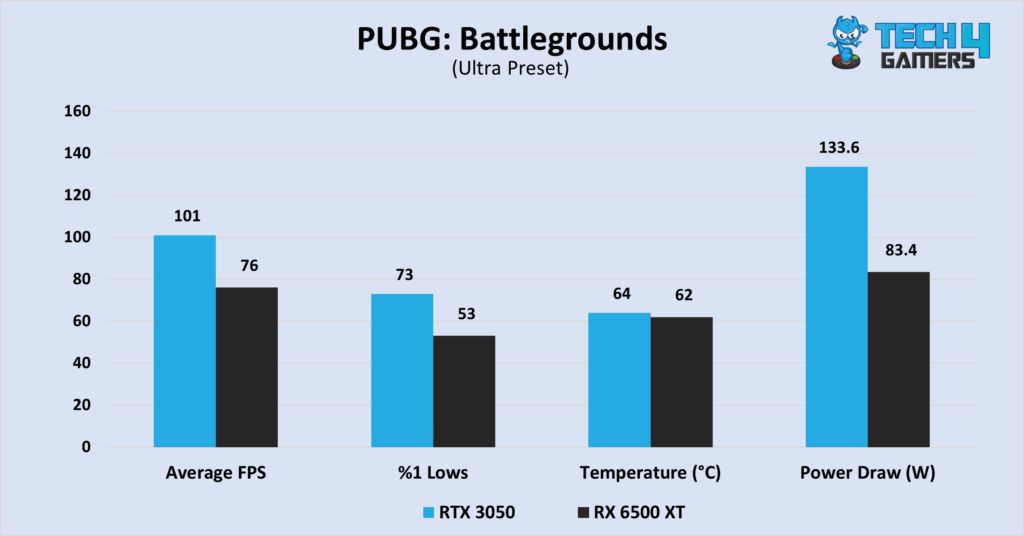
- Going over to our final test, with PUBG: Battlegrounds running at ultra, the RTX 3050 scored 101 FPS over 76 FPS of the RX 6500 XT.
- In our examination, the RTX 3050 scored 37.7% higher than its AMD rival in regard to the %1 lows.
- Looking at the temperature figures, we see the RTX 3050 running at 64°C. The RX 6500 XT averaged 62°C in return.
- Finally, in terms of power draw, the RTX 3050 recorded 133.6 watts on average in PUBG: Battlegrounds. The RX 6500 XT ends with 83.4 watts.
Overall Gaming Performance
Let’s summarize the 1080P gaming benchmarks.
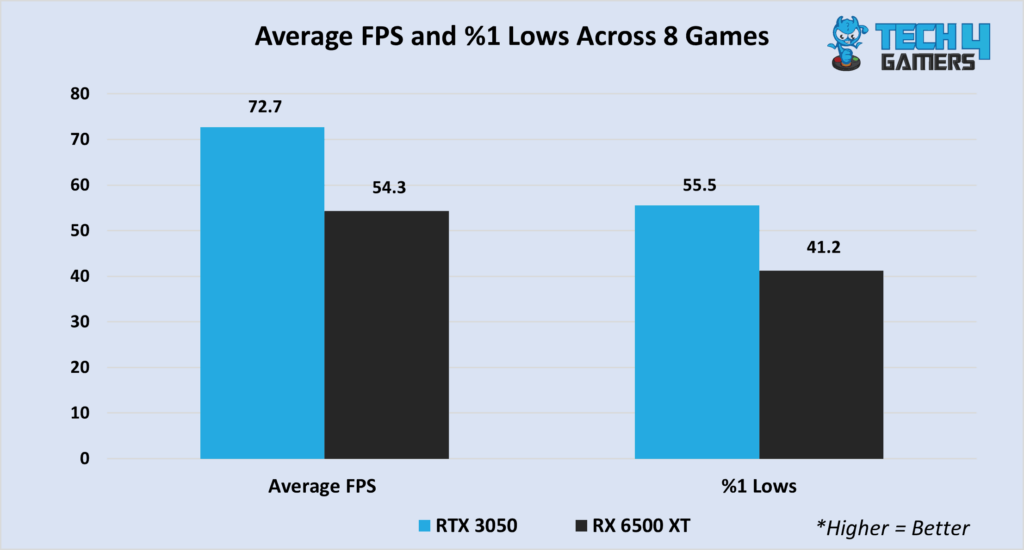
- According to our results, the RTX 3050 averaged 72.7 FPS across the 8 games. In contrast, the AMD RX 6500 XT averaged 54.3 FPS.
- This means the RTX 3050 is 33.8% faster than the RX 6500 XT in 1080P gaming.
- As for the %1 lows, the RTX 3050 scored 55.5 FPS compared to 41.2 FPS of the RX 6500 XT – a 34.7% difference.
Power Consumption
Let’s look at the overall power consumption numbers recorded by the two graphics cards. Remember that Nvidia’s RTX 3050 is rated at 130 watts, whereas the RX 6500 XT has a rating of 107 watts (a 21.4% difference).
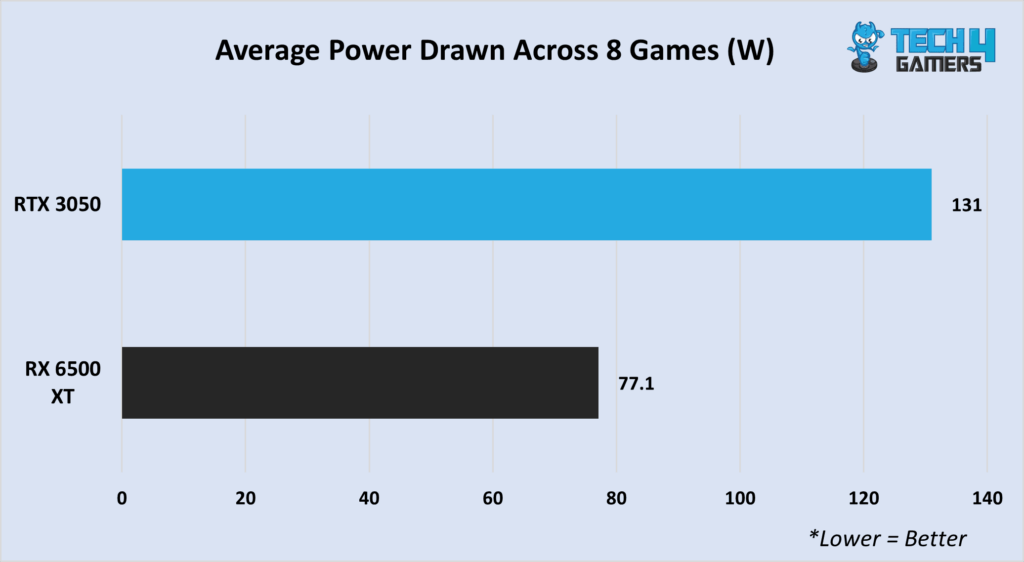
- So, across the 8 benchmarks we conducted, the RTX 3050 averaged 131 watts of power consumption. In comparison, the RX 6500 XT consumed 77.1 watts of power.
- Specifically, this means that the RX 6500 XT is 68.6% more power-efficient than the RTX 3050.
- The RTX 3050 drew just 1 watt of extra power compared to its TDP rating, while the RX 6500 XT consumed power well under its rating of 107 watts, on average.
Overall Thermal Performance
With the GeForce RTX 3050 drawing much more power, does it also run hotter? Let’s see.
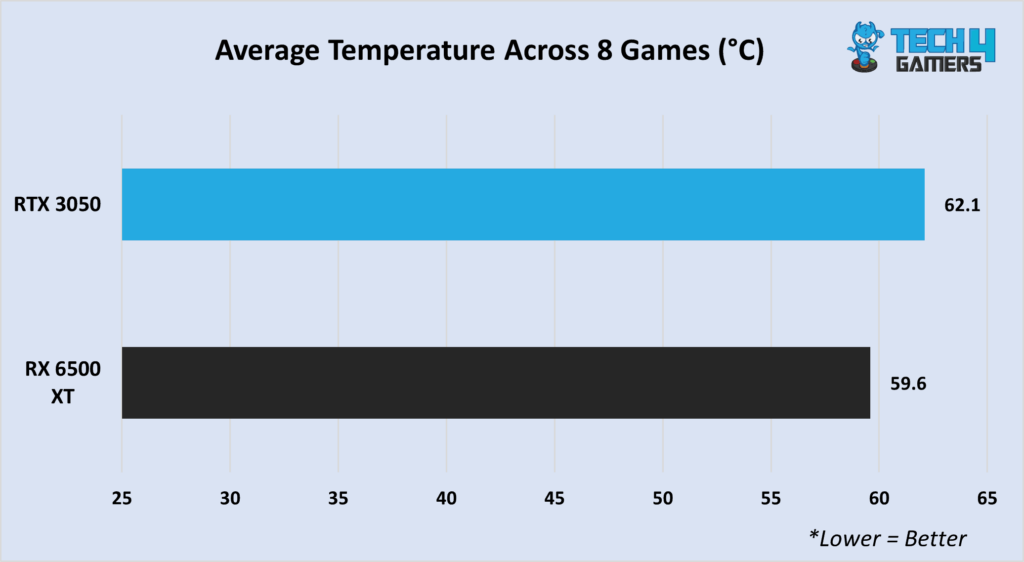
- In terms of our results of thermal management, the RTX 3050 ran at 62.1°C on average, while in contrast, the RX 6500 XT averaged at 59.6°C across the 8 tests.
- Thus, the RX 6500 XT is 4.1% more thermally efficient than the RTX 3050 as far as 1080P gaming is concerned.
Also, if you’re facing rising GPU temperatures, check out our guide on how to lower GPU temperatures.
Prices And Availability
After conducting deep research into the pricing and availability of these cards, we were able to gather the following information.
- The RTX 3050 is readily available for purchase, with an approximate price of 230 USD. You can find it on popular platforms like Newegg.
- Conversely, the Radeon RX 6500 XT offers an affordable alternative, priced at around 160 USD. This graphics card is also conveniently accessible on Newegg.
- It’s essential to consider the cost aspect, as the RTX 3050 comes with a relatively higher price point, representing a 35.8% increase compared to the Radeon RX 6500 XT. Our research has shown that these differences in pricing and availability can significantly influence your choice.
Which One Would We Recommend?
Our recommendation would be to go for the RTX 3050 if you prioritize gaming performance and don’t mind the slightly higher cost. On the other hand, if you’re budget-conscious and prioritize power and thermal efficiency, the RX 6500 XT offers excellent value.
Pros And Cons
| Core i7-14700K | Core i7-14700K | Ryzen 7 7800X3D | Ryzen 7 7800X3D |
|---|---|---|---|
| Pros | Cons | Pros | Cons |
| Outstanding performance | High power consumption | Impressive gaming performance | Lack of support for DDR4 memory |
| Four additional E-cores than before | Prone to overheating | Integration of PCIe 5.0 technology | Absence of an included cooler |
| GPU | Pros | Cons |
|---|---|---|
| GeForce RTX 3050 |
|
|
| Radeon RX 6500 XT |
|
|
More From GeForce RTX 3050:
Thank you! Please share your positive feedback. 🔋
How could we improve this post? Please Help us. 😔
[Hardware Reviewer]
Hi! I’m Ali Tauseef, and I have been writing for Tech4Gamers since 2022. I love all things computer hardware but am particularly fond of CPUs and motherboards, and I like to stay up-to-date about the latest advancements in these worlds, and when possible, write about it. When I’m not doing that, I like to get into a little FPS action in CS2 or get lost in the vast world of RDR2.
Get In Touch: ali@tech4gamers.com


 Threads
Threads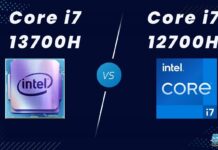
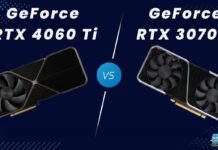
![Core i5-13400 Vs Ryzen 5 7600 [We Tested 9 Games] Core i5-13400 Vs Ryzen 5 7600](https://tech4gamers.com/wp-content/uploads/2023/04/Comparison-1-218x150.jpg)
